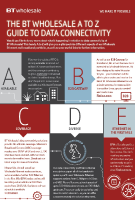Speed is king
When it comes to the internet, it’s no secret that speed is king. We’ve come a long way since the 56k dial-up speeds of 1993 but there is still a long way to go. It seems like only yesterday that Fibre to the Cabinet (FTTC) broadband was launched. It now offers top speeds of 80Mbps and is already reaching out to millions of homes and businesses, so what’s next and can we keep up?
The important thing here is intelligence. Having lived through internet infrastructure development in the nineties and noughties we have learned the importance of being on the leading edge, using the latest networks to develop products and services for our customers. We go through the pains of being early adopters of infrastructure technology in the hope that we can offer customers benefits right at the point of which they make a huge difference to their business. It’s about backing new technology development to continually push the boundaries of internet speed and performance, which is why we are working with Openreach on its G.fast project.
What’s next?
So how does this help? By learning from trials and pilots we gain valuable insight and G.fast is certainly an exciting development. G.fast was initially announced in early 2015 and had its first trial in Huntingdon 6 months later, giving access to 2000 homes and businesses. The trial was a success with almost all premises hitting download speeds of 300Mbps or greater and upload rates of 50Mps. The next step is to deploy pilot schemes in Cherry Hinton near Cambridge and Gillingham in Kent, both of which are targeted for early next year. This will see G.fast run over existing copper networks.
The plan of course is to keep pushing the limits and BT has already talked about a 1Gbps internet capability on its existing network by 2020. Until that time, we are using everything at our disposal to improve speed limits and reliability, using FTTC to extend reach and offer a variety of price points to encourage fibre uptake. This is about meeting customer demands now but also future proofing the network for our customers by investing in tomorrow’s technology.
Benefits for resellers
So what does this mean for resellers? Certainly for resellers selling to small and home office businesses this is a big deal. As more and more companies allow employees to work remotely the demand for greater speeds and bandwidth will only increase with voice over the IP network becoming a must-have rather than a nice-to-have service. The beauty of G.fast bandwidth is that other services and internet uses should not suffer at the hands of other internet traffic sharing the connection. Bandwidth-intensive services such as Ultra-HD 4k and 8k streaming and next-generation IPTV, advanced cloud-based storage, and communication via HD video will all be possible.
Openreach expects that over 10 million premises will be connected to G.fast by 2020 but we have to work within its immediate constraint too. While G.fast speeds are achieved on a subset of premises currently offered FTTC, it means we will have to work with our resellers to forge packages and price points to meet the demands of the varying users. We expect a lot of interest as this is one of those infrastructure speed leaps that not only boosts what is possible in the home but also leads to innovation in business, start-ups working towards maximising the new tech.
As we are working to consume Openreach technology enhancements and capability as early as possible investing time and resources into developing G.fast-ready services for the pilots and eventual launch, we are ensuring our customers and their end users can benefit as soon as G.fast hits the streets, not months or years later. We have a privileged position working on tomorrow’s internet world and translating it into viable solutions for today.
Get In Touch
0800 671 045
Call us for sales enquiries about our products and services
Request A Callback
Get in touch if you'd like us to call you back about a sales enquiry
Sales Enquiries
Contact us online about your sales enquiry
All Other Enquiries
Find out more ways to contact us.


